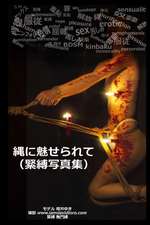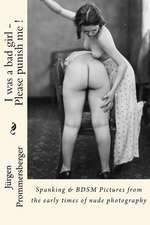I Write to Tell You of a Baby Boy Born Only Yesterday . . . .
Autor David Eustaceen Limba Engleză Hardback – 30 sep 2014
This is the first ever retrospective of David Eustace, one of the world's leading photographers. This eclectic mix of portraiture, landscape, and social observation has been hotly anticipated by the media and public for years. From photographs of Sir Paul McCartney to stunning images of Yosemite, this book will captivate and amaze in equal measure.
Preț: 389.13 lei
Preț vechi: 427.77 lei
-9% Nou
Puncte Express: 584
Preț estimativ în valută:
74.53€ • 76.78$ • 62.43£
74.53€ • 76.78$ • 62.43£
Carte disponibilă
Livrare economică 01-15 februarie
Preluare comenzi: 021 569.72.76
Specificații
ISBN-13: 9781908337214
ISBN-10: 1908337214
Pagini: 256
Ilustrații: Approx. 250
Dimensiuni: 292 x 371 x 28 mm
Greutate: 2.63 kg
Editura: Clearview
ISBN-10: 1908337214
Pagini: 256
Ilustrații: Approx. 250
Dimensiuni: 292 x 371 x 28 mm
Greutate: 2.63 kg
Editura: Clearview
Notă biografică
Introduction
David Eustace
Photographer
Hon Dr of Arts / Photography
This book is a snapshot, a rather long exposure perhaps, covering many events and encounters that I’ve been fortunate enough to experience these past two and a half decades. Some of these moments took place only weeks ago, while others were recorded, almost 25 years ago, at the very early stages of my love affair with the medium. Every photograph is of my past and in compiling this publication I have been able to begin a new chapter, chronicling them not only for myself but also for an audience far greater than my existing one.
Some years ago I lost almost a third of my negatives in a house fire. If you’d asked me before the event how I’d feel at such a loss I’d probably, justifiably, have described it as my worst nightmare. Time and circumstance made such an event a reality yet, strangely, feeling trapped in a nightmare was not my eventual conclusion. Indeed if anything I viewed the episode as a valuable life lesson; I gained a deeper understanding of the continuous learning process that the medium has offered me. Many of my negatives and records are sadly gone and many others damaged beyond repair. However, the memories of my encounters still exist and that is what is truly important to me in photography. My camera has facilitated introductions to new people and places in my life that arguably would not have occurred otherwise. My desire to take photographs was not destroyed that day. Curiously, I became very interested in how the fire had given these negatives a new look and purpose. Twisted and scarred, these negatives were still a record of my past. Now these little strips of plastic had indeed witnessed and recorded another chapter in my life that prior to such an event would have been unimaginable, and which was never their primary purpose. I’ve come to appreciate over the years that we rarely tread the path we anticipate.
In my early teens I accidentally came across a letter telling of my adoption. Prior to this I had no idea I‘d been adopted and in truth it meant little to me, or so I thought. The world I lived in then was so very different from the world I’m fortunate to experience now and the images contained within this book were not even a pipe dream in my teenage years! One thing has been consistent and that is my unwavering interest in people and places. I’ve always been open to change and tried to embrace the idea that all things happen for a reason. As I’ve grown older, I’ve come to appreciate the journey in front of us all and the magical opportunities we must make every effort to grasp. I strive to capture these moments as a record of the journey.
So why wait 20-odd years to publish a collection of my work?
Well, the honest truth is… I really don’t know. I suppose it’s a little like pressing the shutter of a camera and knowing it just feels right. Perhaps it’s now time for a change or a new direction in my life and work or just time to document my past. The answer, then, might be… my instinct tells me now is the time!
The opening words of the letter, dated the day after I was born, were little more than that, just words to me as a teenager. However the older I became, their wording, meaning and all that was written thereafter grew in importance as I began to think of how the letter had affected others – especially those for whom it was intended: my adoptive parents and, equally, the woman unaware of its wording but very much aware of its story, my birth mother. Events and circumstance can often bring strangers together, even in brief moments, but some of these moments can have a momentous effect as time forms a clearer map of who we are, or who we believe we are.
My photography, like my letter of adoption, is incredibly personal. The photographs form a major part of my identity and record the journey I’ve experienced this past quarter century. These collections of the images offered in this book have been selected from some of my favourite portfolios and projects over the years. They are not in any chronological order nor are they in order of importance. Each image supports the other and I’ve deliberately elected not to give each portfolio a title. My intention is for the images to flow, one into the other, and form a bigger picture.
My hope is that this work, be it the entire book or a certain portfolio, a single frame, character, look or a landscape might encourage or inspire you. Even the smallest detail in a single frame may provoke or arouse. If any of these images can do this then, in my view, they have no greater value or purpose.
Moments are all we have. Our past is gone and our future not yet here. I am fortunate to be able to photograph my moments, my world, the way I see it and would now invite you to enjoy part of my journey so far… that of the baby boy born only yesterday.
Brought up in working class Glasgow, David Eustace worked in a variety of jobs including as a prison officer in Glasgow’s notorious prison, HM Barlinnie. It wasn’t until his late twenties that he discovered photography, and within a year of graduating, was working weekly for GQ, ES, Tatler, Vogue, Sunday Times magazine and Sunday Telegraph magazine. Living between New York and Glasgow, he is internationally recognised as a ‘photographer’s photographer’ whose simple and no-nonsense pictures seem reflective of his life’s experiences.
Extras
Foreword
Susan White
Photography Director
Vanity Fair
I first met David more than 10 years ago and he struck me then as a man on a quest. He seemed a seeker, of sorts, out to answer his life’s questions by turning his lens on others yes, not a vapid expression among them. I remember thinking that I was meeting a man and a photographer not quite content with the making of beautiful imagery, a photographer who might be looking for something beyond the world of commercial photography. David certainly made a journey; through life and around the world. It’s what we see now in this very personal body of work.
Travellers of all sorts inevitably face the need to choose their path and eventually reckon with roads taken and those ignored. Spaced throughout these pages are pictures of real roads of great distance that speak metaphorically to us about our own journeys as well as to David’s real trek. He brings our gaze deep into the horizon, reminding us how difficult it is to see the end from the beginning; that the backward glance may be a bit more crystal clear than the forward-looking eye, which tempts us to sometimes observe without really seeing. The first page of this wonderful book of photographs gives us an early sense of where we are going as viewers and travelling companions into David’s world. Marie MacDonald, of the Committee of Social Service, made more than a prediction in a letter that serves as this book’s introduction when she suggests that David, soon to be adopted, should be “dressed for the journey”.
And it’s his journey” that David turns over to us here. By looking so honestly at his subjects, he invites them to return his gaze, risking self - discovery in the reflection of an eye. Whether he finds that self there or at the end of one of those long roads he’s travelled is, of course, a private matter. What he’s sharing with us, though, is the unflinching response he pulls out of his subjects, all of whom look back at us assuming common ground. But it’s not just people that lure David, it’s the physical world of where they are that also reels him in. In turn, he takes us there, too; whether he’s looking at an imposing mountain crag with an almost human face or the unique geometry of an exotic rooftop. He treats fabric as if it’s stone and turns a rock formation into a billowing, fluid ream of striped cloth. Reeds in a pond; unraveled yarn in red, yellow and blue or worn, wooden floor planks become abstracted images distilled into line, colour and form. There are plain, weathered walls that match some of the faces he documents in these pages; some famous, many not, all compelling.
David left a crisp outline of himself behind after our meeting in my office all those years ago and I never forgot him. I’m delighted to meet him again in this book, to imagine his travels, to see the people he’s met and to recognize his legacy not only in his work but in the beautiful face of his daughter, who so gracefully serves as a visual endnote to the photographic journey David shares with us here.











